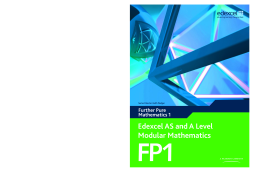
BOOK
Edexcel AS and A Level Modular Mathematics Further Pure Mathematics 1 FP1
(2016)
Additional Information
Book Details
Abstract
Edexcel and A Level Modular Mathematics FP1 features:
- Student-friendly worked examples and solutions, leading up to a wealth of practice questions.
- Sample exam papers for thorough exam preparation.
- Regular review sections consolidate learning.
- Opportunities for stretch and challenge presented throughout the course.
- ‘Escalator section’ to step up from GCSE.
- Solutionbank contains fully worked solutions with hints and tips for every question in the Student Books.
- Exam Café includes a revision planner and checklist as well as a fully worked examination-style paper with examiner commentary.
Table of Contents
| Section Title | Page | Action | Price |
|---|---|---|---|
| Cover | Cover | ||
| Contents | ii | ||
| About this book | iv | ||
| Chapter 1: Complex numbers | 1 | ||
| 1.1: Real and imaginary numbers | 2 | ||
| 1.2: Multiplying complex numbers and simplifying powers of i | 5 | ||
| 1.3: The complex conjugate of a complex number | 7 | ||
| 1.4: Representing complex numbers on an Argand diagram | 10 | ||
| 1.5: Finding the value of r, the modulus of a complex number z, and the value of ϴ, the argument of z | 14 | ||
| 1.6: The modulus-argument form of the complex number z | 19 | ||
| 1.7: Solving problems involving complex numbers | 21 | ||
| 1.8: Solving polynomial equations with real coefficients | 24 | ||
| Summary of key points | 31 | ||
| Chapter 2: Numerical solutions of equations | 32 | ||
| 2.1: Solving equations of the form f(x)=0 using interval bisection | 33 | ||
| 2.2: Solving equations of the form f(x)=0 using linear interpolation | 35 | ||
| 2.3: Solving equations of the form f(x)=0 using the Newton-Raphson process | 38 | ||
| Summary of key points | 40 | ||
| Chapter 3: Coordinate systems | 41 | ||
| 3.1: Introduction to parametric equations | 42 | ||
| 3.2: The general equation of a parabola | 45 | ||
| 3.3: The equation for a rectangular hyperbola and finding tangents and normals | 52 | ||
| Summary of key points | 62 | ||
| Review Exercise 1 | 63 | ||
| Chapter 4: Matrix algebra | 72 | ||
| 4.1: Finding the dimension of a matrix | 73 | ||
| 4.2: Adding and subtracting matrices of the same dimension | 74 | ||
| 4.3: Multiplying a matrix by a scalar (number) | 76 | ||
| 4.4: Multiplying matrices together | 77 | ||
| 4.5: Using matrices to describe linear transformations | 82 | ||
| 4.6: Using matrices to represent rotations, reflections and enlargements | 86 | ||
| 4.7: Using matrix products to represent combinations of transformations | 90 | ||
| 4.8: Finding the inverse of a 2*2 matrix where it exists | 95 | ||
| 4.9: Using inverse matrices to reverse the effect of a linear transformation | 99 | ||
| 4.10: Using the determinant of a matrix to determine the area scale factor of the transformation | 101 | ||
| 4.11: Using matrices and their inverses to solve linear simultaneous equations | 103 | ||
| Summary of key points | 106 | ||
| Chapter 5: Series | 107 | ||
| 5.1: The Σ notation | 108 | ||
| 5.2: The formula for the sum of the first n natural numbers, Σr | 110 | ||
| 5.3: Formulae for the sum of the squares of the first n natural numbers, Σr2, and for the sum of the cubes of the first n natural numbers, Σr 3 | 114 | ||
| 5.4: Using known formulae to sum more complex series | 116 | ||
| Summary of key points | 121 | ||
| Chapter 6: Proof by mathematical induction | 122 | ||
| 6.1: Obtaining a proof for the summation of a series, using induction | 123 | ||
| 6.2: Using proof by induction to prove that an expression is divisible by a certain integer | 127 | ||
| 6.3: Using mathematical induction to produce a proof for the general terms of a recurrence relation | 130 | ||
| 6.4: Using proof by induction to prove general statements involving matrix multiplication | 133 | ||
| Summary of key points | 136 | ||
| Review Exercise 2 | 137 | ||
| Examination style paper | 142 | ||
| Answers | 144 | ||
| Index | 155 |
